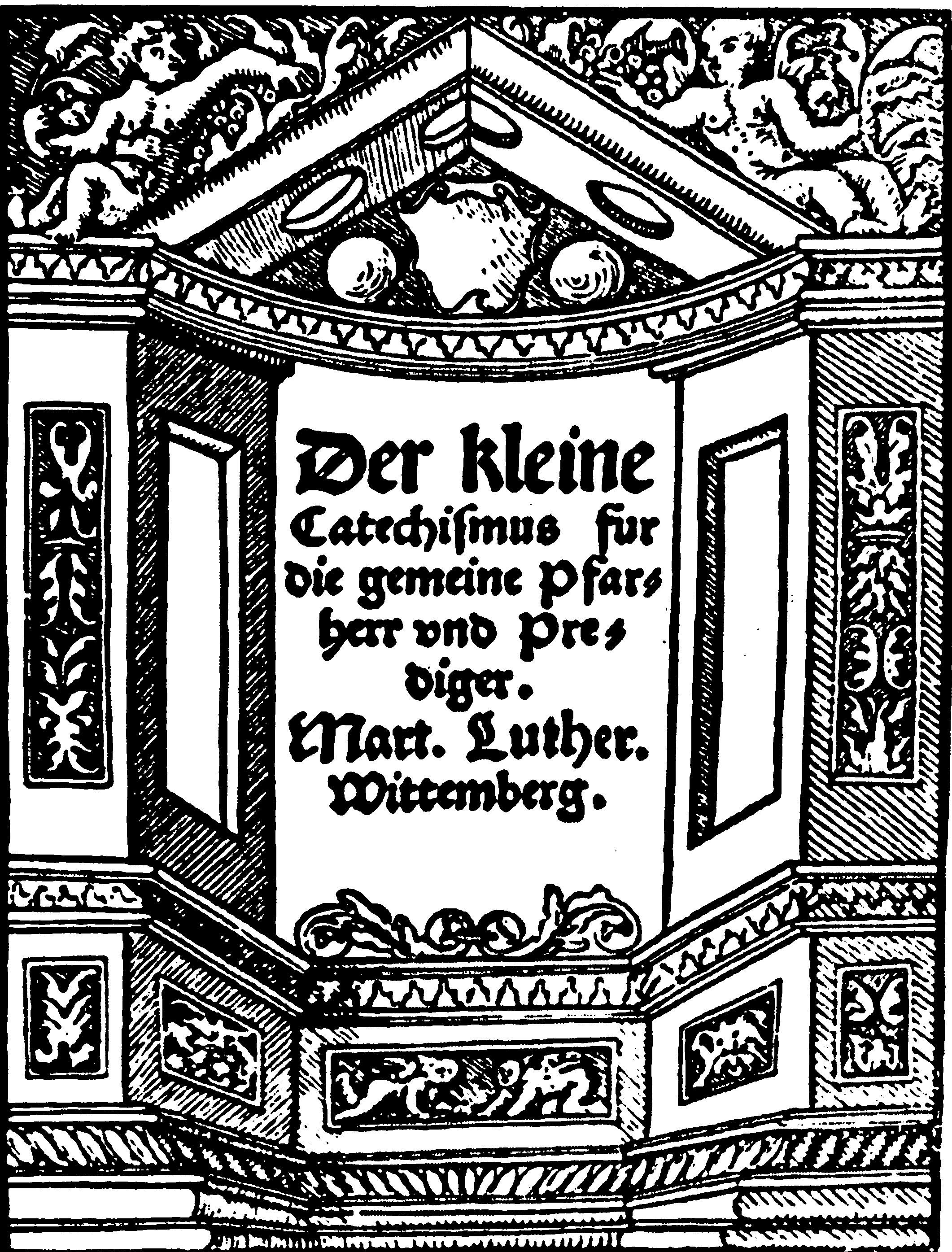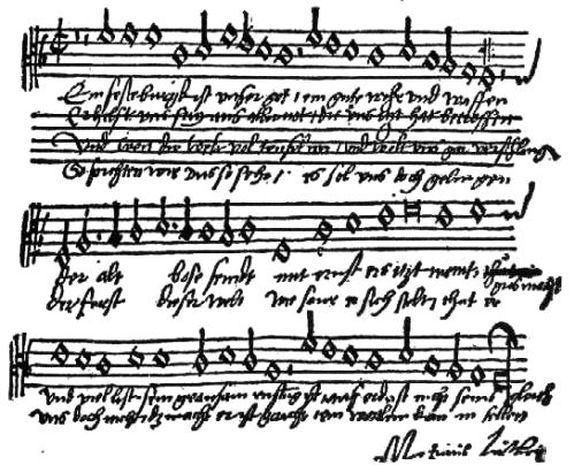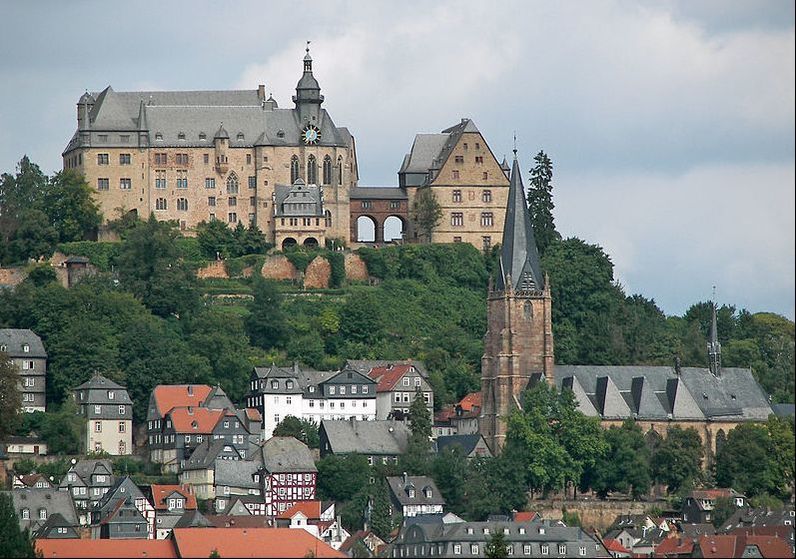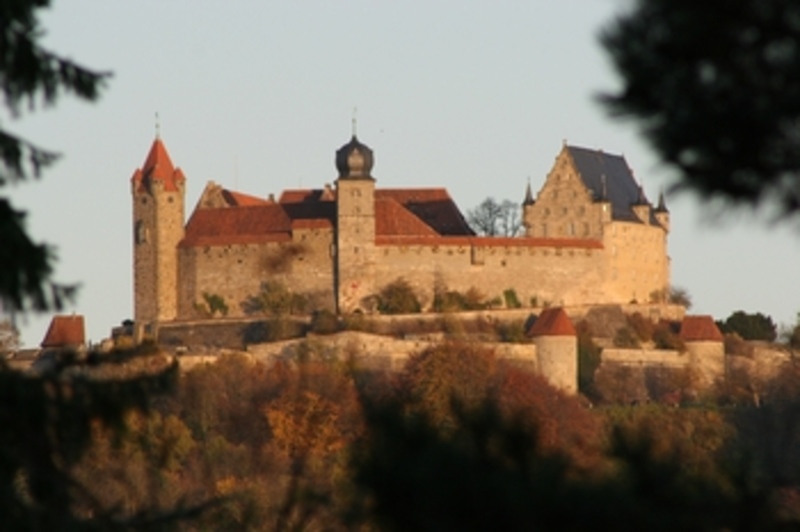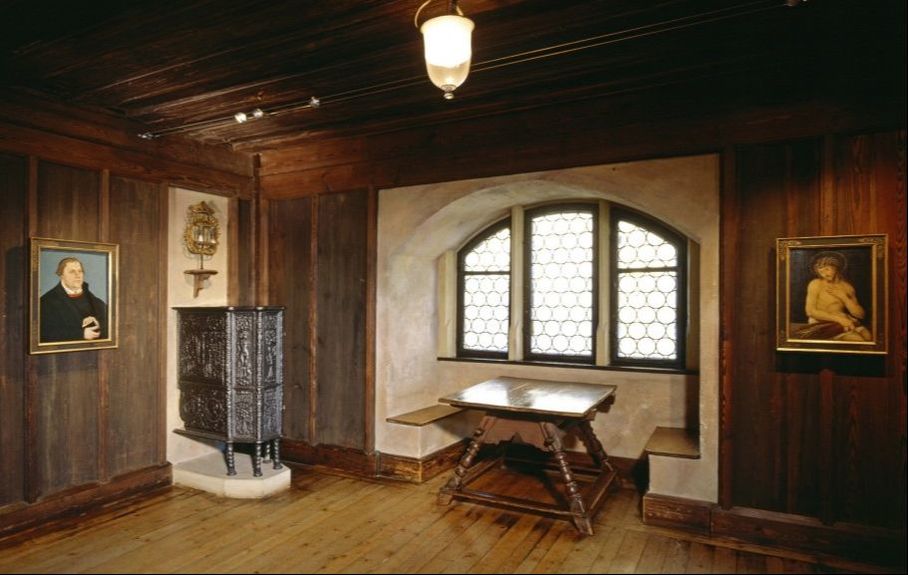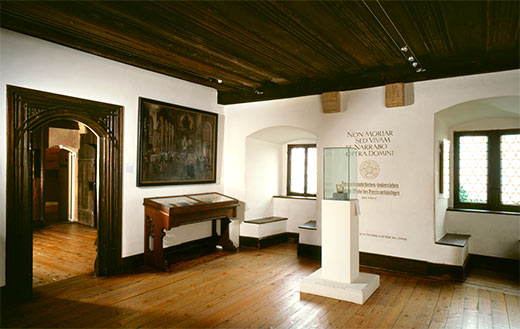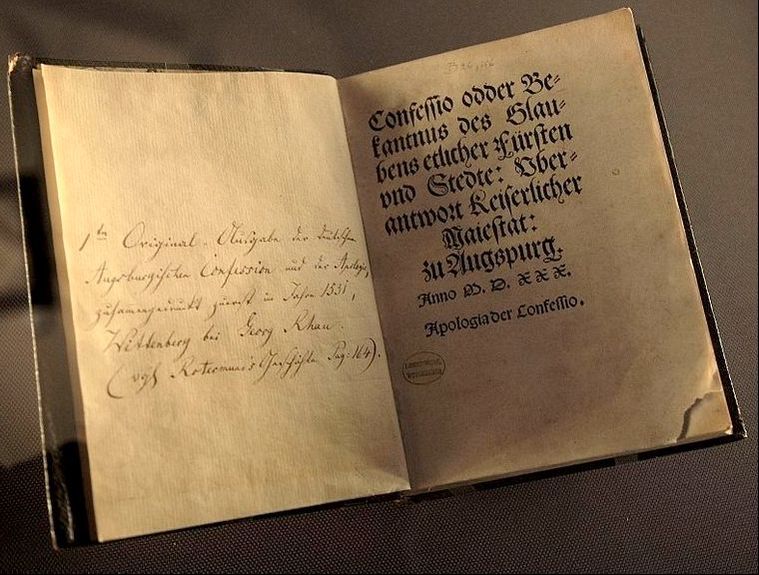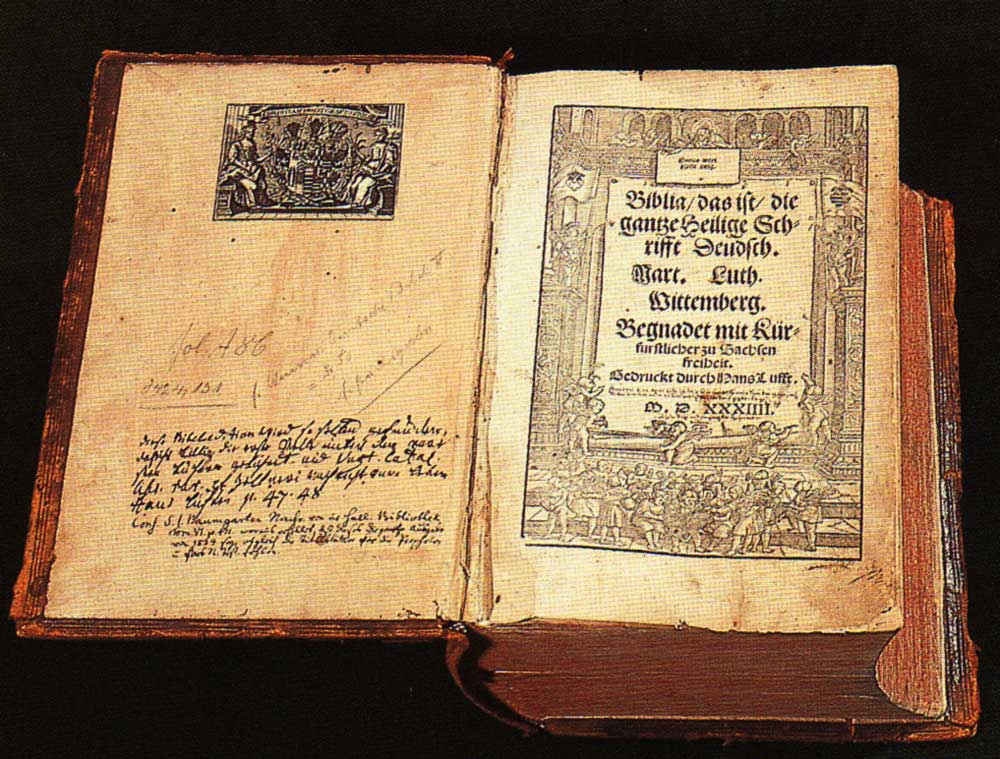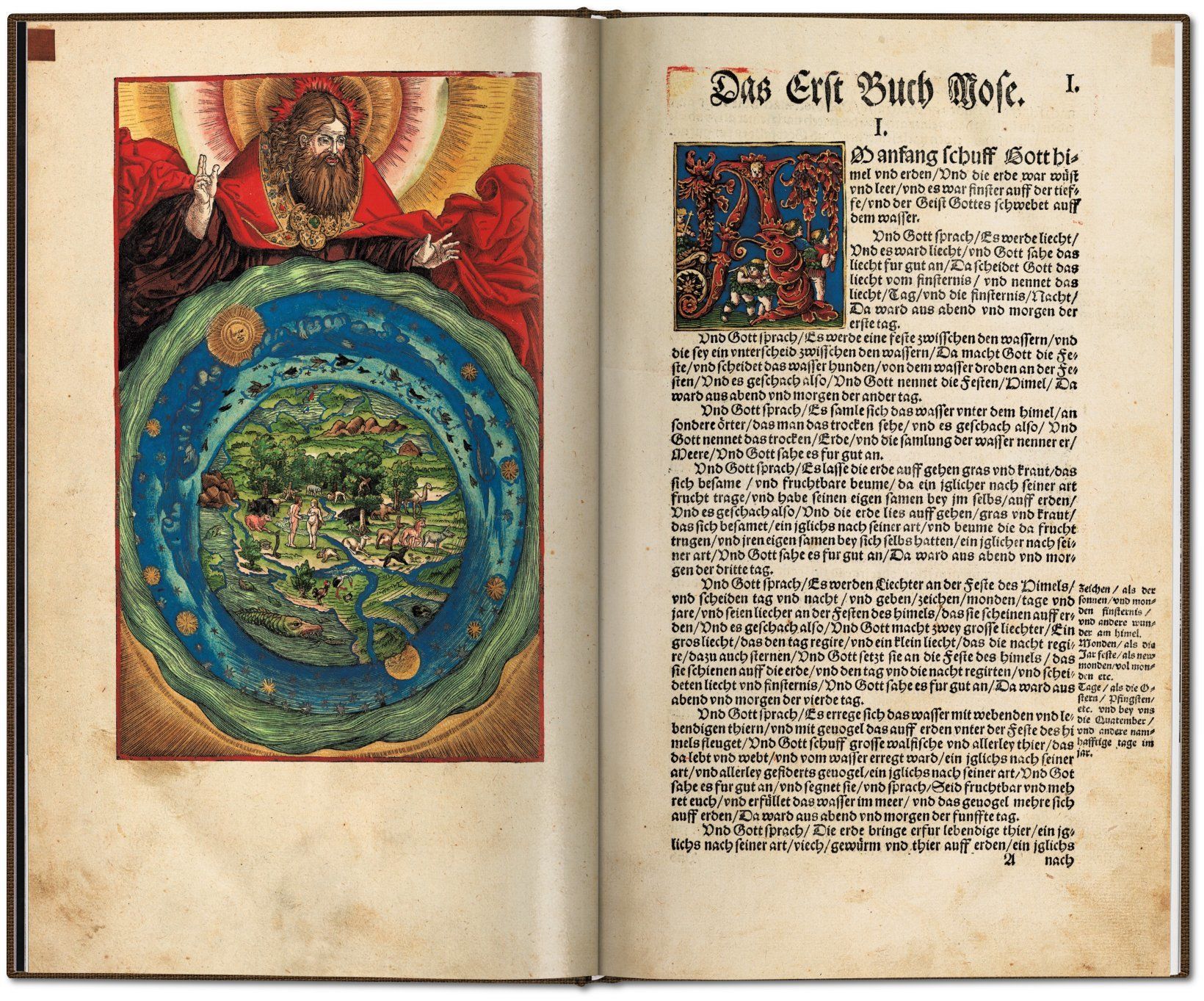Background | Luther's Early Years | Luther the Reformer | Church Leader | Later Years | Life After Luther | Luther Trail
Luther Trail
With a strong and often abrasive personality, Luther took up the weapons of pen and pulpit against the corruptions of Catholicism on one side and the extremes of the Radical Reformation on the other. He spoke out against clerical celibacy, papal abuses, the denying of the scriptures and the communion wine to non-clergy, the cult of saints, salvation by works, and other Catholic doctrines. Luther's late-in-life marriage was an island in a storm. Nearly everything else was chaos... worsening health... the Turks... Black Death... births (and deaths) of children... S composing hymns, translating, writing, writing and more writing... a hard-hearted emperor Charles... the Pope...
A Mass For the People and the Bible SingsJanuary 1526 (age 42) Luther published Deutsche Messe und Ordnung Gottis Dientis (German Mass and Order of Divine Service), a collaboration by Luther, Conrad Rupff and Johann Walther. It was written in German for common people and was based on the Catholic service. But everything that hinted of sacrifice was omitted. It allowed for a longer sermon; communion included both bread and wine. Luther blasted those who criticized his concept of real presence in the communion elements:
It is precisely the same devil who now assails us through the fanatics by blaspheming the holy and venerable sacrament of our Lord Jesus Christ, out of which they would like to make mere bread and wine as a symbol or memorial sign ...They will not grant that the Lord's body and blood are present, even though the plain, clear words stand right there: Eat, this is my body, Drink, this is my blood. June 7, 1526 - Johannes Luther II, known as Hans, was born. Per ancient custom, Hans was bound in a tightly wrapped cloth. Luther said,
Kick little fellow. That is what the Pope did to me, but I got loose." August 1526 - The Imperial Diet of Speyer made Protestant reforms legal. Local rulers were able to decide how much reform they wanted within their own territories. The Diet temporarily suspended the Edict of Worms and its condemnation of Luther, who saw it as a reprieve on the charge of heresy. The action of the Diet, along with an ongoing feud between Emperor Charles and Pope Clement was highly favorable to the Reformation.
Luther suffered heart problems and dizziness (possibly Meniere's disease) in addition to his perennial digestive and intestinal difficulties. He attributed his poor health to the severity of his life in the monastery. April 1527 - Luther wrote Whether these Words: This is My Body. Christ reigns in such a way that the Emperor who persecutes Luther for the Pope is forced to destroy the Pope for Luther. May 1527 - Instead of fighting the Ottoman Turks, mutinous Spanish troops and German mercenaries of Holy Roman Emperor Charles V marched against Pope Clement VII who joined Francis I of France in founding the League of Cognac, an alliance of France, Milan, Venice, Florence and the Papacy that opposed Charles. With their pay in arrears, Charles' troops looted Rome. An estimated 6,000 to 12,000 people were killed and many of the soldiers who remained in city died from diseases caused by the large number of unburied corpses. During the attack, Clement sought refuge in the Castel Sant’Angelo in Rome and then lived outside the city for almost a year.
The sack of Rome marked damaged the papacy's prestige and freed Charles V to act against the Reformation in Germany and against those German princes who sided with Luther, who commented: Mid summer 1527 - Plagued by ill health Luther suffered from depression. He felt powerless to help those of his followers suffering for their faith.
August 2, 1527 - Black death struck Wittenberg. Elector John evacuated the university to Jena, but Luther remained in Wittenberg to minister to the plague victims. His son Hans contracted the plague but survived. December 1, 1527 - Elisabeth Luther was born, but she was not well, possibly because of Katharina's exposure to the black death while pregnant. By the end of 1527, Saxony was, for all practical purposes, entirely Protestant. May 4, 1528 - Elisabeth Luther, 7 months old, died. Katharina wrote: The good Lord gave me a little girl, the sweet little Elisabeth. I am happy and grateful to the Lord! Here, the plague is dead and buried. However, it seemed as if the terrible scourge had marked the child, even before she was born. After seven months, the sweet little Elisabeth said goodbye to her father and her mother to go to Christ, passing through death into life. And Luther wrote to a pastor in Zwickau:
My little daughter, my little Elisabeth, has died. It is marvelous how this grieves me; it has left my spirit almost womanish, so much am I moved by compassion. I never could have believed before that parents’ spirits could be so tender toward a child. February 21, 1529 (age 45) - Second Diet of Speyer (held through April 22) set aside the first Diet's judgment. The Catholics believed it to be a fair compromise. The Lutheran princes felt that "Christ was again in the hands of Caiaphas and Pontius Pilate." They refused to accept the decree and drafted a document that began:
We protest by these presents, before God, our only Creator, Preserver, Redeemer, and Savior, and who will one day be our Judge, as well as before all men and all creatures, that we and for our people, neither consent nor adhere in any manner whatsoever to the proposed decree, in anything that is contrary to God, to His holy word, to our right conscience, to the salvation of our souls. From this statement the terms "Protestant" and "Protestantism" became associated with the Church Reform movement.
Teaching the Faith
March 1529 - Luther published the Small Catechism to help families learn the basic truths of the Christian faith. It contained explanations of the Apostles' Creed, Ten Commandments and Lord's Prayer. The deplorable condition in which I found religious affairs during a recent visitation of the congregations, has impelled me to publish this Catechism, or statement of the Christian doctrine, after having prepared it in very brief and simple terms. Alas! What misery I beheld! The people, especially those who live in the villages, seem to have no knowledge whatever of Christian doctrine, and many of the pastors are ignorant and incompetent teachers. Martin Luther, Wittenberg, 152 April 23, 1529 Luther's Large Catechism published for use by teachers and preachers. It covered the same ground as his Small Catechism, but in greater detail
ca. 1529 - Around 1529 Luther wrote the music and lyrics of "A Mighty Fortress is our God" (German, Ein feste Burg ist unser Gott). The words are a paraphrase of Psalm 46. The hymn was popular with the common people of reformation Germany, being sung continually in the streets and chanted by martyrs as they awaited their grim fate. One writer said that Luther provided the hymn so that the people could answer God in their songs.
The Devil hates music because he cannot stand gaiety, and Satan can smirk but he cannot laugh; he can sneer but he cannot sing. May 4, 1529 - Magdalena Luther born. She was the third child but first surviving daughter. Luther reported to Nicholas von Amsdorf that Katharina had gone into labor and after three hours, had delivered, without any difficulties, a perfectly healthy baby daughter. She was a much loved child and she was nicknamed Lenchen. Luther also asked Amsdorf to be godfather to "the little heathen and to help her [enter] holy Christendom through the holy, precious sacrament of baptism."
October 1-4, 1529 - Marburg Colloquy (conference) convened. Luther met with Ulrich Zwingli at Marburg Castle. German and Swiss theologians attempted to hammer out a theological statement they both could agree on, hoping for unity between the Protestants. After agreeing on 15 articles of faith (infant baptism, the word of God, grace, confession, etc.), the discussions focused on the nature of the Lord's Supper. Luther maintained that the consecrated bread and wine were united to the true body and blood of Christ for all participants to eat and drink "this is my body, this is my blood"). Zwingli considered bread and wine only symbols of the body and blood of Christ. (How could anyone deny infant baptism after watching their own child die unexpectedly, as Luther had to do with his 7-month-old daughter Elisabeth}. The conference ended without an agreement, but did lead the way to later agreements, for example, the Schmalkaldic League of 1531 and the Wittenberg Concord of 1536. Augsburg Confession April 1530 (age 46) - In an effort to restore church unity and rally support against a Turkish invasion, Emperor Charles V called on the German Princes to present a summary of Lutheran beliefs at the Diet of Augsburg. Elector John of Saxony directed Martin Luther, Justus Jonas, Johannes Bugenhagen, Georg Spalatin and Philipp Melanchthon to meet in Torgau and draft a summary of Lutheran beliefs to be presented to the Holy Roman Emperor at the diet. This summary was called the "Torgau Articles." On April 3, the elector and the reformers left Torgau and, on April 23, reached Coburg Castle, about 56 miles south of Erfurt. Luther summed up his first impression of the great fortress: "It is a perfectly charming place and suitable for studying." Luther was left behind because he was an outlaw according to the Edict of Worms. From April to October 1530, during the duration of the Diet of Augsburg, Martin Luther sought protection at the Veste, He was given two rooms opposite the Great Court Chamber.
May 1, 1530 - While Luther was at Coburg he received word that his father Hans had died.
This death has certainly thrown me into sadness, thinking not only of nature, but also of the very kind love, for through him my Creator has given me all that I am and have. May 2, 1530 - The reformers, minus Luther, reached Augsburg. On the journey, Melanchthon worked on a draft using the Torgau Articles and sent it to Luther at Coburg on May 11 for his approval. On May 13 Luther wrote to Elector John: "I have read through Master Philipp's Apologia (as the Augsburg Confession was first known), which pleases me very much; I know nothing to improve or change it." On June 23, the final form was adopted.
In the Confession Melanchthon sought to defend Lutherans against misrepresentations and to provide a forceful statement of beliefs that would be acceptable to the Roman Catholics, and thus be the basis for reconciliation between the Lutheran Reformers and the Roman Church. June 25, 1530 - The Lutheran princes insisted on a public reading of the confession, as opposed to presenting it to the Emperor. Two Saxon chancellors, one with the Latin copy, the other with the German, stepped into the middle of the assembly, and against the wish of the emperor, the German text was read. The reading lasted two hours and allegedly was so distinct that every word could be heard by those outside the chapel were the meeting took place. Over the next three months, Johann Eck and other theologians wrote the Confutatio Pontificia stating the Catholic position on the 28 articles of the Augsburg Confession. Eck's first draft was so wordy and "vicious" that the Catholic princes refused to submit it to Emperor Charles until it was twice edited and toned down. On August 3, 1530, the revised version of the Confutation was read at the Diet. It rejected the statements of the Augsburg Confession. The Emperor declared that it properly presented the Catholic faith. Melanchthon hastily wrote a lengthy argument, the Apology of the Augsburg Confession, supporting the Augsburg Confession and refuting the arguments made in the Confutation. It was presented to the Emperor but he refused to accept it. November 19, 1530 - The Diet of Augsburg ended without achieving a compromise. Emperor Charles V declared that the Lutheran confession had been repudiated and reinstated the Edict of Worms, which condemned reform and outlawed those who advocated it. He threatened military force if the reformers failed to consent to return to Catholic practices by April 15, 1531. After Melanchthon returned to Wittenberg, he obtained a copy of the Confutation and rewrote and expanded his Apology to more clearly and completely explain the faith of the Reformers. A Latin edition was completed in April or May and a German translation by Justus Jonas was published in the autumn of 1531. Luther spent 165 days at Coburg Castle during the Diet of Augsburg, strikingly parallel to his 11 months at the Wartburg. But now he had a family. While at the Coburg Luther continued with his work translating the Bible and the writings of Aesop, He wrote more than 120 letters, carried by messengers on horseback to his friends in Augsburg and his family in Wittenberg. There were highly imaginative descriptions of his temporary home: "Of the empire of the birds," of "the castle full of demons," He was disturbed by the squawking jackdaws and crows. He also composed more than a dozen treatises. He steadied the Lutheran participants at the Augsburg Diet and kept them from rash decisions. He pressed Philip of Hesse to stand firm and avoid compromise on the meaning of the Lord's Supper, lest it throw the Lutheran cause into reverse. On May 20, 1530, he wrote to Elector John Frederick, urging patience and strength in the midst of what must be "a tiresome situation." Indeed it must have been an often irksome situation; on the one hand, the theologians, led by Melanchthon, were forever changing the wording of the Augsburg Confession. On the other hand, everyone had to wait patiently for the emperor's arrival as he dallied in Italy and then in Innsbruck. The stay in Coburg was one of the most productive times of Luther's life Summary of the 28 statements of belief of the Augsburg Confession
The first twenty-one articles outline what the Reformers believed were the most important teachings in Lutheranism, based on the Bible. The last seven articles identify some of the wrongs and abuses of the Roman Catholic Church and provide arguments for needed reforms. Christians believe in the Triune God and reject other interpretations regarding the nature of God.
1531 (age 47) - Luther wrote Warning to his Beloved Germans, discussing the rightness of armed resistance to the emperor. He left the choice to take up arms to the Protestant rulers. February 27, 1531 - Schmalkaldic League established by Philip I, Landgrave of Hesse, and John Frederick I, Elector of Saxony, the two most powerful Protestant rulers at the time. It originated as a defensive alliance, with the members pledging to defend each other should their territories be attacked by the Holy Roman Emperor Charles V. But, the League quickly became a territorial political movement when breaking from the Catholic Church offered significant economic advantages. In December 1535, the league admitted anyone who would subscribe to the Augsburg Confession. June 30, 1531 - Margarethe Luther (Martin's mother) died. November 9, 1531 - Martin Luther, Jr. was born. Luther said, "If you become a lawyer I will hang you on the gallows. You must be a preacher, baptize and dispense the sacrament, visit the sick and comfort the sorrowful." (Martin did study theology, but he devoted his time to scholarly pursuits and never had a regular parish call.) 1532 (age 48) - Religious Peace of Nurnberg granted German Protestants free exercise of religion until further notice. 1533 (age 49) - Luther helped reform the theology faculty at the University of Wittenberg. January 1533 - King Henry VIII of England married Anne Boleyn. Three months later she gave birth to a daughter, Princess Elizabeth (future Queen Elizabeth I). Pope Clement VII responded to the marriage by excommunicating Henry. January 29, 1533 - Paul Luther was born. 1534 (age 50) - After twelve years Luther finished translating the Old Testament into German. There are some who have a small opinion of the Old Testament, thinking of it as a book that was given to the Jewish people onlybut Christ says, 'Search in the scriptures, for they give testimony of me' ... therefore the Old Testament is to be highly regarded. 1534 - Luther's first full Bible translation into German, including the Old Testament, was published in a six-part edition. It was a collaborative effort of Luther, Johannes Bugenhagen, Justus Jonas, Caspar Creuziger, Philipp Melanchthon, Matthius Aurogallus, and Georg Rorer. Before Luther died Hans Lufft printed thirteen editions of this Bible; 253 editions were published outside of Wittenberg. A completely revised edition appeared in 1541. The illustrations in some copies were later hand-colored. The initial printing of 3,000 sold out within three months.
Luther's goal was to equip every German-speaking Christian with the ability to hear the Word of God, and his completing his translation of the Old and New Testaments from Hebrew and Greek into German by 1534 was one of the most significant acts of the Reformation. Although Luther was not the first to attempt such a translation, his was superior to all its predecessors. Previous translations had contained poor German, and had been from the Vulgate Latin translation, i.e. translations of a translation rather than a direct translation into German from the originals. Luther sought to translate as closely to the original text as possible, but at the same time his translation was guided by how people spoke in the home, on the street and in the marketplace. Luther's faithfulness to the language spoken by the common people was to produce a work which they could relate to. Germans everywhere bought Luther's Bible, not only for the salvation of their souls, but for prestige. It was the must-have book. Everyone read it or listened to it being read. Its phrasing became the people's phrasing, its speech patterns their speech patterns. Hans Lufft, whose printing press was set up in the basement of the Luther home, printed over one hundred thousand copies between 1534 and 1574, which were read by millions. Luther's Bible was present in virtually every German-speaking Protestant’s home. Luther even had large-print Bibles made for those who had failing eyesight. 1534 - Ignatius Loyola founded the Society of Jesus (Jesuits) with the purpose of preaching and winning over new converts to the Catholic church. Jesuits dedicated themselves to teaching and stressed the importance of preaching and obedience to the Pope; believed it was essential for Christians to unite and that Protestant theology was flawed.
September 25, 1534 - Death of Pope Clement VII. October 13, 1534 - Clement was succeeded by Alessandro Farnese, who took the name Paul III. March 21, 1536 (age 52) - Wittenberg Concord, a conference of Lutheran and Zwinglian theologians, meet at Luther's home. They achieved some compromise but very little understanding or 1537 (age 53) - In preparation for an intended ecumenical Church council Elector John Frederick "the Magnanimous" of Saxony asked Luther to prepare a summary of Lutheran beliefs for presentation at a meeting of the Schmalkaldic League. February 9-20, 1537 (age 53) - Luther arrived in Schmalkalden for a meeting of the Schmalkadic League. Luther's patron, Elector John Frederick of Saxony, had asked him to prepare a summary of Lutheran beliefs in preparation for an intended ecumenical Council of the Church. John wished to determine what issues could be negotiated with the Roman Catholics and what could not be compromised. However, Luther became seriously ill with a severe case of kidney stones The Schmalkald Articles, as they became known, are divided into three sections.
February 17, 1537. This document, the Treatise on the Power and Primacy of the Pope, Tractate for short, was adopted as an appendix to the Augsburg Confession, which did not have a specific article dealing with the office of the Papacy. Statements from Melanchthon's Tractate:
|
Timeline
|

